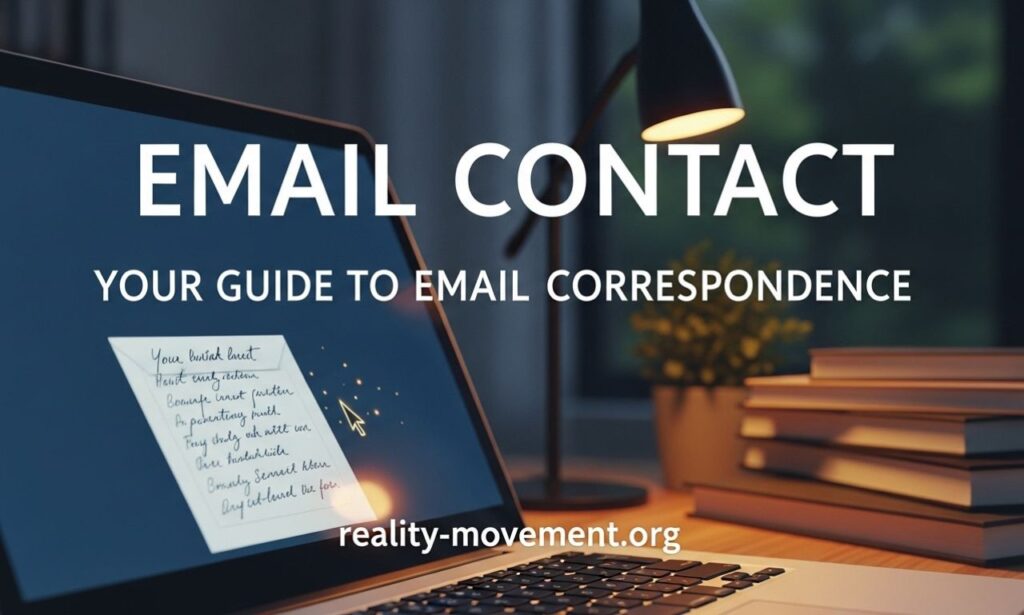In today’s fast-paced digital world, email contact reality-movement.org dor remains a vital tool for communication. From professional correspondences to friendly check-ins, understanding how to navigate this medium can enhance your interactions immensely. Whether you’re reaching out for business opportunities or simply wanting to keep in touch with friends and family, mastering the art of email correspondence is essential.
Imagine sending an email that not only conveys your message but also leaves a lasting impression. That’s the power of effective communication through emails. With just a few tips and tricks up your sleeve, you can transform mundane messages into engaging conversations.
Ready to dive into the realm of email contact? Let’s explore what makes reality-movement.org dor so unique and how you can leverage it for better connections!
What is email contact reality-movement.org dor?
Email contact reality-movement.org dor is a dedicated communication channel for the Reality Movement organization. It serves as a bridge between individuals interested in its mission and the team behind it.
This email address allows users to reach out with questions, feedback, or collaboration ideas. It’s designed to foster connections within a community that shares similar values and goals.
Using this specific email contact helps streamline communication. Whether you’re seeking information about events or wanting to engage in discussions related to the movement’s initiatives, this address is your go-to resource.
By connecting through this platform, you can play an active role in supporting their vision while keeping yourself informed on relevant updates and opportunities.
Setting Up an Email Address
Setting up an email address is a straightforward process that opens doors to communication. First, choose a reliable email provider such as Gmail, Outlook, or Yahoo. These platforms offer user-friendly interfaces and solid security features.
Next, you’ll need to select a unique username. This could be your name or something creative that reflects your personality. Make sure it’s easy to remember yet professional if it’s for work purposes.
Once you’ve chosen your username, create a strong password. A combination of letters, numbers, and special characters works best for keeping your account secure.
Fill in any required personal information during the setup process. This often includes recovery options like phone numbers or secondary emails—just in case you forget your password later on!
With these steps completed, you’re all set to dive into the world of email communication.
Proper Email Etiquette
Proper email etiquette is essential for effective communication. Start with a clear and concise subject line that reflects the content of your message. This helps recipients prioritize their emails.
Always address the recipient appropriately. Use “Dear” for formal communications or simply their name in casual exchanges. It’s important to establish the right tone from the start.
Keep your messages straightforward and focused. Avoid unnecessary jargon, as clarity should be your goal.
Use professional language throughout, even if you’re familiar with the person you’re contacting. Emojis and informal slang can lead to misunderstandings in a professional context.
Don’t forget to proofread before hitting send! Simple typos can undermine your credibility. End with an appropriate closing, like “Best regards” or “Sincerely,” followed by your name and contact information.
Remember, being polite goes a long way; thank people for their time when necessary.
Tips for Writing Effective Emails
Writing effective emails is a crucial skill in today’s fast-paced digital world. Start with a clear subject line that reflects the content of your message. A concise subject helps recipients prioritize their reading.
Be direct in your opening sentences. State your purpose clearly to capture attention right away. Avoid long-winded introductions; get straight to the point.
Use simple language and short sentences for clarity. Break up text into paragraphs, making it easy to digest information quickly.
Always maintain a polite tone, even if addressing issues or complaints. A respectful approach encourages positive responses.
Include a call-to-action at the end of your email, guiding the recipient on what you expect them to do next. This could be answering questions or scheduling a meeting.
Proofread before hitting send—typos can undermine professionalism and credibility significantly.
Common Mistakes to Avoid in Email Communication
One of the most frequent mistakes in email communication is neglecting to proofread. Typos and grammatical errors can tarnish your professionalism. Take a moment to review before hitting send.
Another common pitfall is using vague subject lines. A clear, specific subject line helps recipients prioritize their inboxes effectively. Don’t leave them guessing about your message’s purpose.
It’s also crucial to avoid overly lengthy emails. Keep your messages concise and to the point, respecting the reader’s time while ensuring clarity.
Ignoring attachments can lead to confusion or frustration. If you mention an attachment, ensure it’s included before sending.
Remember that tone can be easily misinterpreted in written form. Be mindful of how your words may come across and adjust accordingly for better understanding.
Dealing with Spam and Phishing Emails
Spam and phishing emails clutter inboxes, making it hard to focus on what matters. Recognizing these threats is the first step toward a safer email experience.
Spam typically involves unsolicited messages meant to promote products or services. They often fill your inbox with irrelevant content. Filters can help, but it’s essential to mark unwanted emails as spam so they learn over time.
Phishing attempts are more dangerous. These emails mimic legitimate sources, aiming to steal sensitive information like passwords or credit card details. Always check for discrepancies in sender addresses or odd requests for personal data.
If you suspect a phishing attempt, do not click any links or download attachments. Reporting such emails helps protect others too.
Regularly updating your email security settings adds an extra layer of protection against these nuisances while keeping your correspondence safe from prying eyes.
Best Practices for Managing and Organizing Your Emails
Managing your emails effectively can reduce stress and boost productivity. Start by creating folders or labels for different categories, such as work, personal, and urgent matters. This method helps you locate important messages quickly.
Set aside dedicated time each day to check your inbox. Avoid constant email checking; it disrupts focus. During this time, aim to process each message promptly—either respond, archive, or delete.
Implement filters to automatically sort incoming emails based on criteria like sender or keywords. This way, less critical emails won’t clutter your main inbox.
Regularly unsubscribe from newsletters and notifications that no longer interest you. Keeping only the relevant subscriptions ensures a cleaner inbox.
Consider using tools like calendars or task managers integrated with your email client to track deadlines and follow-ups effortlessly. These practices create a streamlined email experience that enhances both communication and organization.
How to Use Email Correspondence to Enhance Your Professional and Personal Relationships
Email contact reality-movement.org dor can be a powerful tool for building connections. Use it to keep in touch with colleagues and friends alike. A simple message checking in can make a big difference.
When reaching out, personalize your emails. Referencing past conversations or shared experiences shows that you care. It helps strengthen the bond between you and the recipient.
For professional relationships, don’t hesitate to share valuable resources. Articles or tools relevant to their work demonstrate thoughtfulness and expertise. This kind of engagement fosters collaboration.
On a personal level, sharing updates about your life builds familiarity. Send photos from recent events or ask about their family’s milestones.
Always respond promptly to emails. Timely replies signal respect for others’ time and reinforce trust within relationships—both personal and professional alike.
Conclusion
Email correspondence is an essential part of both our personal and professional lives. Understanding how to navigate this form of communication can significantly enhance your interactions. Whether you’re reaching out through email contact reality-movement.org dor or any other platform, the key lies in clarity, etiquette, and organization.
Effective emails foster better relationships and ensure that your messages are received positively. By setting up a proper email address and adhering to best practices, you can present yourself professionally while avoiding common pitfalls like spam or phishing attacks.
Remember that each message you send reflects on you as a communicator. Taking the time to craft thoughtful responses will pay off in building stronger connections with friends, colleagues, clients, or anyone else within your network.
Stay vigilant against unwanted emails and keep your inbox tidy for maximum productivity. With these tools at your disposal, you’re well-equipped to take full advantage of what email correspondence has to offer. Embrace it as a means of connection rather than just another task on your list; you’ll find it enriches both aspects of life—personal and professional alike.






